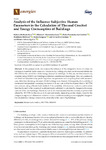Analysis of the Influence Subjective Human Parameters in the Calculation of Thermal Comfort and Energy Consumption of Buildings

Use este enlace para citar
http://hdl.handle.net/2183/23264Colecciones
- Investigación (FIC) [1685]
Metadatos
Mostrar el registro completo del ítemTítulo
Analysis of the Influence Subjective Human Parameters in the Calculation of Thermal Comfort and Energy Consumption of BuildingsAutor(es)
Fecha
2019Cita bibliográfica
ROBLEDO-FAVA, Roberto, et al. Analysis of the Influence Subjective Human Parameters in the Calculation of Thermal Comfort and Energy Consumption of Buildings. Energies, 2019, vol. 12, no 8, p. 1531.
Resumen
[Abstract] In the present work, we analyze the influence of the designer’s choice of values for the human metabolic index (met) and insulation by clothing (clo) that can be selected within the ISO 7730 for the calculation of the energy demand of buildings. To this aim, we first numerically modeled, using TRNSYS, two buildings in different countries and climatologies. Then, we consistently validated our simulations by predicting indoor temperatures and comparing them with measured data. After that, the energy demand of both buildings was obtained. Subsequently, the variability of the set-point temperature concerning the choice of clo and met, within limits prescribed in ISO 7730, was analyzed using a Monte Carlo method. This variability of the interior comfort conditions has been finally used in the numerical model previously validated, to calculate the changes in the energy demand of the two buildings. Therefore, this work demonstrated that the diversity of possibilities offered by ISO 7730 for the choice of clo and met results, depending on the values chosen by the designer, in significant differences in indoor comfort conditions, leading to non-negligible changes in the calculations of energy consumption, especially in the case of big buildings.
Palabras clave
Monte Carlo method
ISO 7730
TRNSYS
ISO 7730
TRNSYS
Versión del editor
Derechos
Atribución 3.0 España
ISSN
1996-1073






